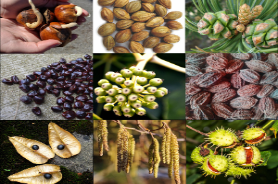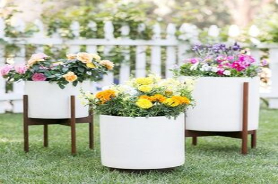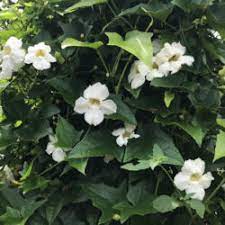Thunbergia grandiflora, commonly known as Blue Trumpet Vine or Bengal Clock Vine, is a vigorous flowering vine native to tropical regions of Asia. It is a member of the Acanthaceae family and is highly regarded for its large, trumpet-shaped blue flowers. Here is some detailed information about Thunbergia grandiflora:
- Description: Thunbergia grandiflora is a fast-growing, woody vine that can reach heights of 6 to 9 meters (20 to 30 feet) with suitable support. It has twining stems that are covered in rough, reddish-brown bark. The leaves are heart-shaped or ovate with a pointed tip, and they have a dark green color and a slightly rough texture.
- Flowers: The most distinctive feature of Thunbergia grandiflora is its showy flowers. The trumpet-shaped blooms are large, measuring about 7 to 10 centimeters (3 to 4 inches) in diameter. They have a striking sky-blue color, although some cultivars may also display white or lavender flowers. The flowers have a lighter throat and five broad petals that overlap to form a bell shape. They emerge from the leaf axils in clusters and bloom throughout the warm months, attracting bees, butterflies, and hummingbirds.
- Blooming Period: Thunbergia grandiflora typically blooms from late spring to fall, although it can produce flowers intermittently throughout the year in favorable conditions.
- Cultivation: Thunbergia grandiflora is well-suited for tropical and subtropical regions. It thrives in full sun to partial shade and prefers well-drained, fertile soil. Regular watering is necessary to keep the soil consistently moist but not waterlogged. The vine benefits from sturdy support, such as trellises, fences, or arbors, as it climbs and twines rapidly. Pruning can be done to control its growth and shape. Thunbergia grandiflora can also be grown in containers with appropriate support.
- Uses: Thunbergia grandiflora is primarily grown as an ornamental vine due to its striking blue flowers and vigorous growth habit. It is often used to cover fences, walls, and pergolas, creating a beautiful vertical display. The vine’s flowers make a stunning addition to cut flower arrangements. Additionally, Thunbergia grandiflora is known to attract pollinators, making it beneficial for garden ecosystems.
- Caution: While Thunbergia grandiflora is prized for its beauty, it is considered an invasive species in some regions outside its native range. Therefore, it’s important to check its status and potential invasiveness in your specific location before planting.
Thunbergia grandiflora, with its large blue flowers and vigorous growth, is a captivating addition to tropical gardens and landscapes. Its vibrant blooms and twining habit make it a focal point, attracting pollinators and adding a touch of color and beauty to outdoor spaces.














Reviews
There are no reviews yet.